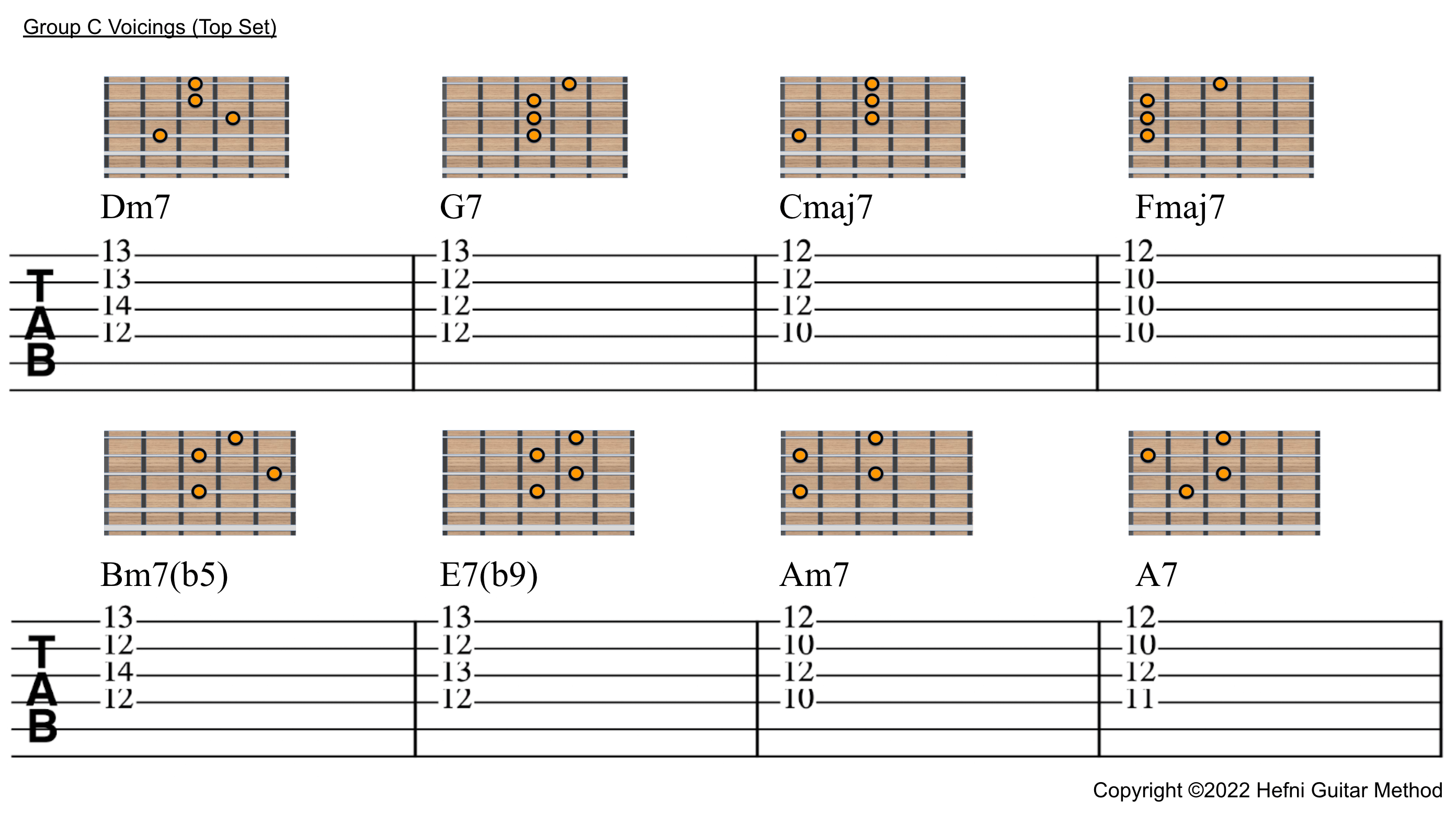Welcome to the Jazz Chords Workshop Lesson 7.
In this week’s lesson, we are going to explore the next voicing group for the major- and minor II V I progression in the key of C major. This week’s voicings will span the 10th to 14th frets on the top 4 strings.
Therefore, let us call this the top structure of Group C Voicings.
Click the video below to watch the lesson.
Learning Aids
The chord shapes and TABs for this lesson are provided as follows.

Primary Takeaways
Here are the main takeaways of lesson 7:
1. This week’s chord voicing group is the upper structure of the Group C voicings.
This week’s voicings are centred around the 10th to 14th frets on the top four strings. These voicings sit squarely over the Dorian scale shape. See Major Scales. In the context of the circle of 5th progression, all the chords are diatonic to this key and scale pattern except the E7(b9) and the A7 chords. As such, see these as borrowed chords which require some alteration to the underlying scale.
2. The chord structures for Dominant 7th and Major 7th differ only in the top note
We will now examine the G7 chord in bar 2 and the Fmaj7 chord in bar 4. Although they are on different frets, their chord structures are similar except for the top note. The bottom 3 notes are barred in both instances. If we examine closely, the top note in G7 is one fret ahead of the 3-note cluster on the 2nd to 4th strings. Consequently, the top note of Fmaj7, is two frets ahead of the 3-note-cluster. This interesting fact will help you navigate between the major7 and the dominant 7th chords on the top strings.
3. The Cmaj7 and Amin7 chord structures differ by one note.
The notes for Cmaj7 are C, E, G, and B whereas the notes for Amin7 are A, C, E and G. If we begin with the Cmaj7 chord tones but lower the B note down by 2 frets to A, the resulting chord tones are C, E, G and A.
Rearranging these notes we get A, C, E, G which are the chord tones for Amin7 (see above).
4. One chord but with 2 names
The Cmaj7 chord above was changed to C, E, G, A, which are also the chord tones for the chord named ‘C6’. Therefore, C6 and Amin7 share the same chord tones albeit in a different order. In other words, C6 and Amin7 are the exact same chord. Playing wise, it does not matter since the chord tones are the same. This means you can substitute Cmaj7 with Amin7 to change Cmaj7 to C6. This gives the progression an ‘older’ jazz sound.
Tips for better learning
Building upon what we have learnt in previous lessons, the following still hold true and may help you remember the concepts.
-
-
-
- The Dm7 and Bm7(b5) chords differ by one note.
- The Cmaj7 and Amin7 chords differ by one note.
- Remember that E7(b9) chord shape is always the same in the same string set.
- The Fmaj7 functions to connect the major II V I to the minor II V I.
- The A7 functions to connect the minor II V I back to the major II V I making it cyclic.
- Only the E7(b9) and A7 are not diatonic to the scale. They are ‘borrowed’ temporarily from other scales/keys.
-
-
Learning Takes Time (so take it slow)
If you have been following this series, you will have learnt 7 different ways to voice the major and minor II V I’s by the end of this lesson. While the objective of the lesson is to learn another voicing group, the overall learning objective of the entire series is to acquire all 12 possible voicing groups variations in the same key.
Students who are aware of this stated objective usually do better than those just seeking to learn one voicing group. Knowing all 12 will provide much a great many options to voice each chord. Do revisit some of the earlier lessons if you desire to develop this level of proficiency.
Follow us on Facebook, Instagram and Youtube.
